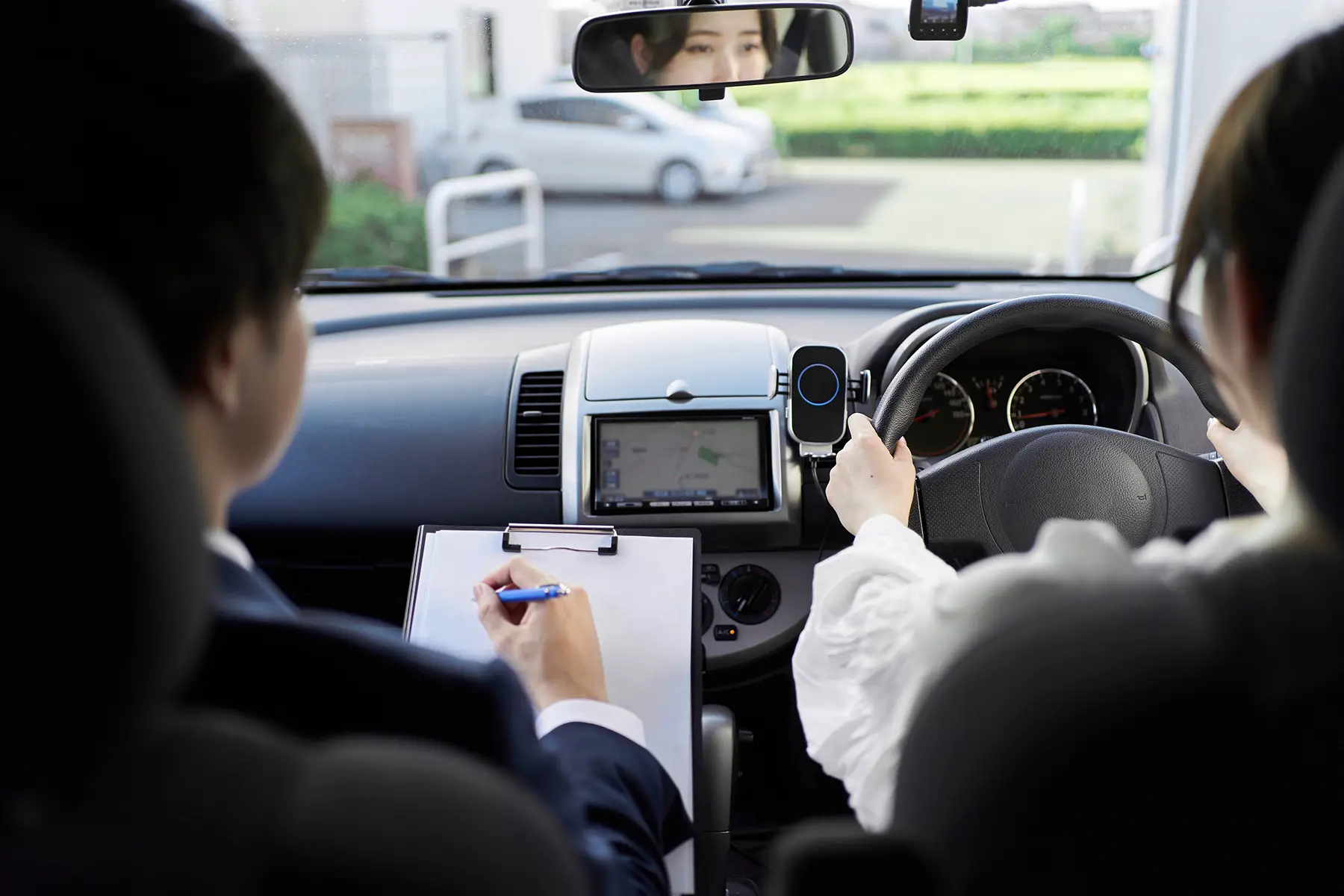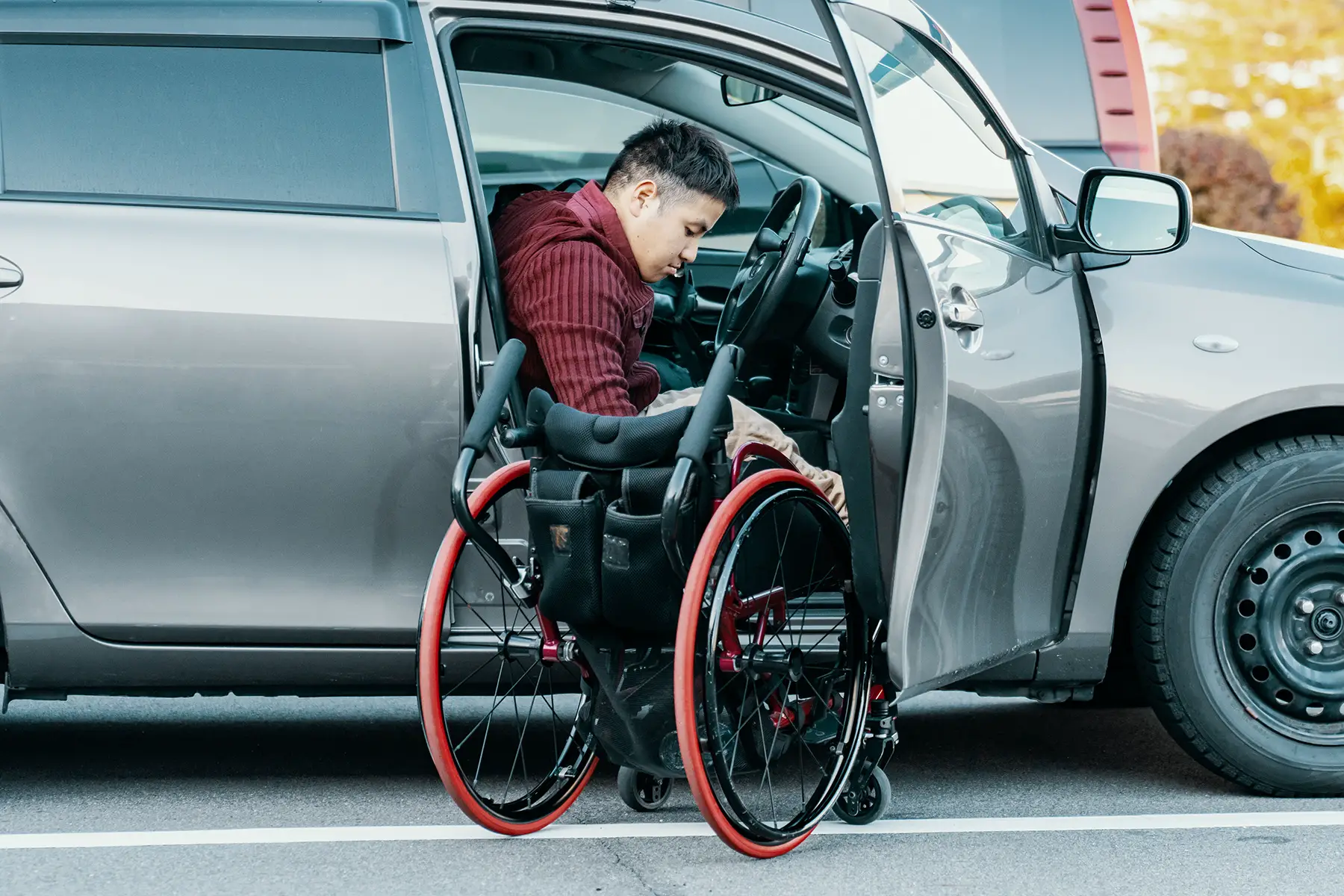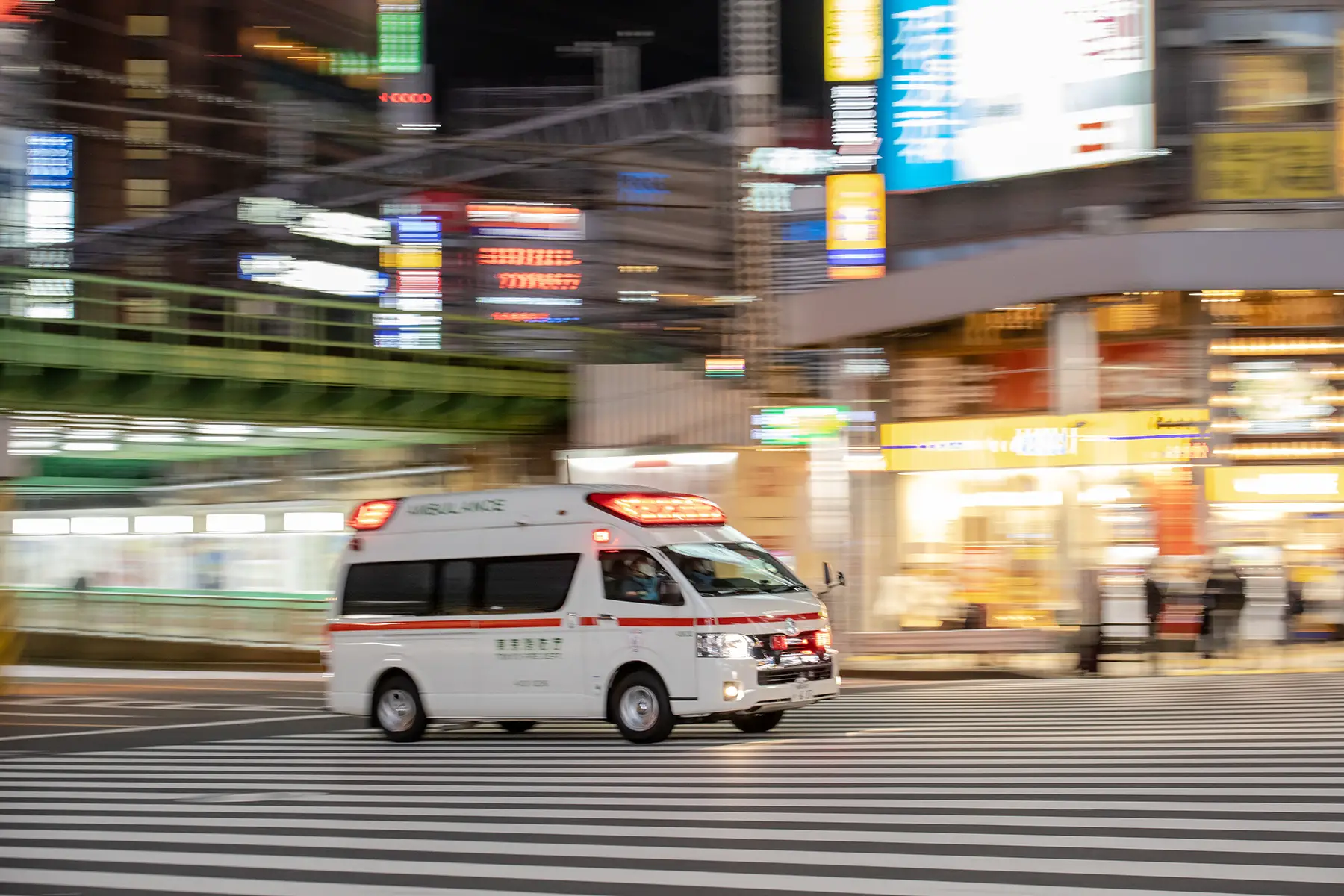A driving license is mandatory when operating a motor vehicle (自動車, jido sha) in Japan (日本, Nihon/Nippon). While some international residents can just exchange their original driving permits, other nationalities may have to complete additional theoretical and practical tests to get a driving license in Japan. This is to ensure applicants understand the strict traffic rules for driving in Japan.
Find out how to apply for a new driving permit or transfer a foreign license in the following sections:
Driving licenses in Japan
The public safety commissions of each Japanese prefecture issue driving licenses, and the National Police Agency (NPA – 警察庁, Keisatsu Cho) oversees the rules and regulations for permits and driving (運転, unten) in the country.

A Japanese driving license (運転免許証, unten menkyo sho) looks like a credit card with a photo, personal details, and the authorized vehicle classification. As such, different vehicle transmission and weight categories require specific licenses. This also applies to an adapted vehicle for a driver with disabilities (i.e., the license may include restriction codes.)
The minimum legal driving age is 18 for standard licenses (普通免許, futsu menkyo) and 16 for motorcycles (二輪免許, nirin menkyo) and mopeds (原付免許, gentsuki menkyo). You can also use your driving license – valid for five years – as a form of ID in Japan.
Short-term visitors can apply for an International Driving Permit (IDP – 国際運転免許証, kokusai unten menkyo sho) from their host country before arriving. An IDP allows the holder to drive in the country for up to 12 months. While it is not practical for longer-term international residents, it works well for first-time arrivals.
Those with an address registered in Japan must apply for a standard driving license. Many expats can simply convert their existing valid permit to a Japanese one because of reciprocal agreements between their countries. Other nationalities must undertake practical driving and written knowledge tests.
The front of a standard Japanese driving license contains the following:
- Address (住所, jusho)
- Conditions (e.g., manual, automatic, or adapted)
- Date of birth (生年月日, sei nen gappi)
- Dates of issue and expiry (YY/MM/DD)
- Dates of issue of previous license
- Full name (氏名, shimei)
- Issuing office reference number
- License number (免許証番号, menkyosho bango)
- Photograph
- Prefectural issuing authority with seal
- Valid license categories (e.g., Provisional, Class 1, or Class 2)
The back of a Japanese driving license will list your name again and whether you are an organ donor. Older driving permits also contained your registered address for ID purposes, but this is now printed on the front.
Getting a Japanese driver’s license
Residents – 18 and older – can apply for a Japanese driver’s license at their local driving license test center (運転免許試験場, unten menkyo shiken jo), which you can find with a quick online search. You need to book the appointments and prepare the relevant documents in advance.

These documents include:
- Official translation of your foreign driver’s license and the original (if you have one)
- Passport (パスポート, pasupoto)
- Recent passport photo
- Resident’s Card (在留カード, zairyu kado)
If the applicant’s home country isn’t part of a reciprocal scheme or they still need to get a license, they must attend driving lessons and pass all tests to obtain their permit.
All drivers would also need to pass a vision test.
Drivers with a disability
In 2021, Japan recorded 181,650 license holders with disabilities driving adapted vehicles. However, the type and level of a person’s disability (障がい, shogai) may determine whether they can apply for a driving license. For example, according to the Road Traffic Act (道路交通法, doro kotsu ho), people with the following disabilities cannot get a license:
- Any intellectual disability significantly impairing a person’s ability to drive safely
- Lost all limbs or limb functions
- Trunk impairment, cannot sit upright
- Visual impairment
The National Police Agency (警察庁, Keisatsu Cho) could provide more detailed information.
Driving tests in Japan
If you are from the following countries and you have a valid license, you do not need to sit any extra tests (apart from the eye exam):
- Australia
- Austria
- Belgium
- Canada
- Czech Republic
- Denmark
- Finland
- France
- Germany
- Greece
- Hungary
- Iceland
- Ireland
- Italy
- Luxembourg
- Monaco
- New Zealand
- Norway
- Poland
- Portugal
- Slovenia
- Spain
- South Korea
- Sweden
- Switzerland
- Taiwan
- The Netherlands
- The United Kingdom (UK)
- The USA (*States of Hawaii, Maryland, Virginia, and Washington only)

In contrast, those without a license or from another country must attend driving lessons and pass the theory (学科試験, gakka shiken) and practical driving tests (技能試験, gino shiken).
First, a student driver will write an exam about the traffic rules (交通規則, kotsu kisoku) and road signs (道路標識, doro hyoshiki) to get their learner’s permit.
Consequently, learner drivers have six months to convert their license into a full permit with a practical driving test. Again, these applicants must also pass an eye test.
You can take these exams at a local testing center in your prefecture.
Japanese driving license tests are notoriously strict. For instance, successful applicants must achieve a written passing grade of 90% and 75% for the practical test. The driving test starts with 100 points, from which the examiner deducts for every infraction.
Driving theory tests
New drivers must first complete 10 hours of driving school lectures and 12 to 15 hours of driving practice. Two theory tests follow this. The first is a 30-minute multiple-choice exam on Japanese driving laws to obtain a learner’s permit (仮免許, kari menkyo).
With this permit, student drivers must undertake a further 19 hours of lectures and 16 hours of practical driving lessons to qualify for the second theoretical exam. It is a 50-minute test with 95 questions and a 90% pass grade.
You can take the pen and paper theory tests – typically in Japanese (日本語, Nihon go) – at a local driving test center. However, all prefectures do provide limited English-language centers, and some even offer Chinese (e.g., Mandarin or Cantonese) and Portuguese options.
Expect to pay around ¥2,550 for the theory test, depending on the prefecture. However, many first-time Japanese drivers opt for an all-in-one driving course with lessons, processing, and testing, costing up to ¥300,000.
Practical driving tests
Applicants must clock up between 31 to 34 hours of driving lessons and complete a two-part practical test to qualify for a valid driving license in Japan.
The first part takes place within a controlled driving school environment to receive a learner’s permit. Upon passing this test, applicants can continue practicing on actual roads to complete the second part within six months.

Additionally, learner drivers’ vehicles must have learner plates and a new driver sticker (初心者マーク, shoshin-sha maku) attached to the car (i.e., an inverted yellow and green chevron). A passenger – with a valid driver’s license – must always accompany them.
To clarify, student drivers must complete at least 16 hours of road experience before booking their final test at a driving school. A good tip is to book the test at the same school they had lessons with to memorize the course and maneuvers in detail.
Again, most examiners will test your driving skills in Japanese. However, there are limited English-language schools available, such as these Tokyo-based ones:
If you do not live in Tokyo, read on to find schools in your region.
Japan’s practical test is a unique exam that involves driving correctly through a narrow, artificial S-curve road and remaining 70cm from the curb at all times. Major mistakes such as hitting the curb or not stopping when signposted will result in an outright fail.
The test fees differ between schools but, on average, cost around ¥2,400 plus extra for car rental and processing.
Driving lessons in Japan
While it isn’t mandatory to enroll in a driving school, it is beneficial. Especially if you do both tests – for a learner and a full driving license – at the same driving school, you would already be familiar with the specific course when being tested.
There are designated (指定自動車教習所, shitei jidosha kyoshu jo) and non-designated driving schools (届出自動車教習所, todokede jidosha kyoshu jo). The former includes ones recognized by the Public Safety Commission (公安委員会, Koan Iinkai) with all-inclusive fees and certification. For the latter, you pay as you go for lessons to practice and improve your skills,
Of course, you will have an instructor at all driving schools.
The minimum required lesson hours are:
- 31 hours for automatic vehicles
- 34 hours for manual vehicles
Learners should also supplement the practical lessons by practicing driving on real roads and in traffic.
If you have limited time, you can join a driving study camp (合宿免許, gasshuku menkyo) to acquire a license within two weeks. These include accommodation, intensive lessons, and testing.
Japanese driving schools
Here is a full list of designated driving schools (per region) by the Japan Federation of Authorized Drivers School Associations (全日本指定自動車教習所協会連合会, Zen-Nihon Shitei Jidosha Kyoshu-jo Kyokai-rengo-kai).
Regions
- Aichi (愛知県)
- Akita (秋田県)
- Aomori (青森県)
- Chiba (千葉県)
- Ehime (愛媛県)
- Fukui (福井県)
- Fukuoka (福岡県)
- Fukushima (福島県)
- Gifu (岐阜県)
- Gumma (群馬県)
- Hiroshima (広島県)
- Hokkaido (北海道)
- Hyogo (兵庫県)
- Ibaraki (茨城県)
- Ishikawa (石川県)
- Iwate (岩手県)
- Kagawa (香川県)
- Kagoshima (鹿児島県)
- Kanagawa (神奈川県)
- Kochi (高知県)
- Kumamoto (熊本県)
- Kyoto (京都府)
- Mie (三重県)
- Miyagi (宮城県)
- Miyazaki (宮崎県)
- Nagano (長野県)
- Nagasaki (長崎県)
- Nara (奈良県)
- Nigata (新潟県)
- Oita (大分県)
- Okayama (岡山県)
- Okinawa (沖縄県)
- Osaka (大阪府)
- Saga (佐賀県)
- Saitama (埼玉県)
- Shiga (滋賀県)
- Shimane (島根県)
- Shizuoka (静岡県)
- Tochigi (栃木県)
- Tokushima (徳島県)
- Tokyo (東京都)
- Tottori (鳥取県
- Toyama (富山県)
- Wakayama (和歌山県)
- Yamagata (山形県)
- Yamaguchi (山口県)
- Yamanashi (山梨県)
Driving with a foreign license in Japan
Most internationals can drive in Japan for up to 12 months with an International Driving Permit (IDP – 国際運転免許証, kokusai unten menkyo sho). These are obtained before arriving in the country.

Those with valid driving licenses from Belgium, Estonia, France, Germany, Monaco, Switzerland, and Taiwan may also drive in Japan for up to 12 months without an IDP. However, the drivers must carry a Japanese translation with their original driving license. After a year, these license holders must transfer their permits to retain any future driving rights in Japan.
Note that if your original license has expired, you will have to go through the whole process to obtain a valid driving license in Japan.
Exchanging a foreign driving license
As mentioned previously, Japan has a reciprocal agreement with 30 countries allowing their nationals to exchange their original licenses for Japanese ones without any additional exams apart from the eye test.
If you hold a driving permit from one of the countries on this list, you can make an appointment at your local license center and take the following paperwork with you:
- Evidence of residence in the country of license authority (during the three-month period following its issue date)
- Foreign driving license
- License translation in Japanese from the Japanese Automobile Federation (JAF – 日本自動車連盟, Nihon Jido-sha Renmei)
- Passport
After the documents have been verified and the applicant has taken an eye test, they will receive a new Japanese driving license on the same day. This license is valid for three years.
Nationalities that do not appear on the list (e.g., Brazil, China, and many US states) must also complete written and practical tests. The written knowledge test is generally conducted after the document screening.
Notably, you would need to pass the driving test within six months of submission, otherwise, you will have to start the whole process again.
Renewing a driver’s license
Japan has three license classes:
- Provisional (仮運転免許, kari unten menkyo): A learner’s permit given to new drivers. This allows you to drive a vehicle affixed with learner plates, while accompanied by a Class 1 license holder.
- Class 1 (第一種運転免許, dai-isshu unten menkyo): A standard driving permit for all private cars
- Class 2 (第二種運転免許, dai-nishu unten menkyo): A specialist driving permit for passenger-carrying vehicles, like taxis. The minimum age for this license is 21 years.
Additionally, each license will also indicate a driver’s experience level with a background color behind the issue date on the card, such as:
- Green (グリーン免許, gurin menkyo): Beginner driver (for two years after obtaining your license)
- Blue (ブルー免許, buru menkyo): Regular driver
- Gold (ゴールド免許, gorudo menkyo): Superior/excellent driver
You only qualify for a Gold license once you have a clean driving record for three years on a Blue license. This status is reassessed every time you renew your driving license. In other words, you can only retain a Gold license status, if you haven’t received any demerit points (i.e., for any traffic violation) since your last license renewal.
The Gold license is valid for five instead of three years, the renewal process is quicker, and the fee is lower.

Unlike in other countries, you can renew your driver’s license in Japan within two months of your birthday, instead of the expiry date. You will receive a notification detailing the process, procedure, and documents by post.
Renewal takes place at the licensing center listed on the notification. Attendees must also view a traffic lecture (corresponding to their license color) and undertake a new eye exam. The center will process and issue the new license on the same day.
Lost or stolen driving licenses
If your driving license (or other legal documents) is lost or stolen, you must report it immediately at a local police station or police box (交番, koban). This involves filling out a form and checking a database for a potential match.
To request a card replacement, go to a driving license center, test center, or driving license section of a police station. License centers are generally the quickest options with same-day turnarounds. Remember to bring the following when you make the application:
- A passport photo
- Fee of ¥3,500
- Proof of identification
Driving licenses in Japan for other vehicles
Apart from the standard driving license, Japan has ten vehicle license categories. While there is some overlap, generally, you must hold a particular category license to drive the corresponding vehicle size.
These categories are:
- Large motor vehicle (大型自動車, ogata jidosha)
- Mid-sized motor vehicle (中型自動車, chugata jidosha)
- Semi-mid-sized motor vehicle (準中型自動車, jun chugata jidosha)
- Special large motor vehicle (大型特殊自動車, ogata tokushu jidosha)
- Special small motor vehicle (小型特殊自動車, kogata tokushu jidosha)
- Standard motor vehicle (普通自動車, futsu jidosha)
- Large motorcycle (大型自動二輪車, ogata jido nirinsha)
- Standard motorcycle (普通自動二輪車, futsu jido nirinsha)
- Motorized bicycle or moped (原動機付自転車, gendoki tsuki jitensha)
- Towing license (牽引免許, ken-in menkyo)
Useful resources
- Japan Automobile Federation (JAF) – provides official Japanese translations for licenses and other important information
- Metropolitan Police Department – provides official police information about Tokyo licenses
- NPA – the National Police Agency (警察庁, Keisatsu Cho) that oversees licensing






